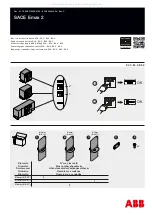
Instruction Book
Effective: May 2016
Page 25
IB131017EN
For more information visit:
www.Eaton.com
Figure 4-4 Positioning Circuit Breaker With Lifter
NOTICE
A number of labels have been applied to the circuit
breaker and its cassette to facilitate the connection and
disconnection of the secondary umbilical cord,
inserting the circuit breaker, levering the circuit breaker
to the CONNECT position and removal of the circuit
breaker. These operations are also described in detail
in this instruction book. Become familiar with the labels
as they not only provide assistance initially, but
provide a good quick reference at a later date when the
instruction book may not be readily available.
With secondary connections to the
circuit breaker only
made
as supplied from the factory, carfully position the
circuit breaker directly in front of its cassette using
appropriate slings and an overhead lifter as described
earlier in paragragraphs
3-2.2
(Figure
4-4
). The cradle
portion (bottom portion) of the drawout circuit breaker is
provided with integrally mounted wheels for rolling on the
floor of the cassette in a guided manner.
Position the circuit breaker so that the two rear wheels
begin to roll on the cassette's floor and then firmly push the
circuit breaker into the cassette until the horizontal shoot
bolts on either side of the breaker cradle contact the front of
the cassette (Figure
4-5
).
Care should be taken not to
bind the secondary umbilical cord between the circuit
breaker and cassette as the circuit breaker is pushed
into its cassette.
At this point the breaker cannot be
inserted any further until the shoot bolts are retracted using the
spring loaded shoot bolt handle on the lower left side of the
cradle (Figure
4-6
). The lifting slings can now be removed
from the circuit breaker.
Figure 4-5 Breaker Shoot Bolts Against Cassette
The shoot bolt handle as shown in Figure 46 has three
labeled positions
Position "A" - Full down position causing the shoot
bolts to retract fully inside the breaker cradle (not
engaged)
Position "B" - Partially up position causing the shoot
bolts to only protrude partially (partially engaged).
Position "C" - Full up position which causes the shoot
bolts to protrude completely (fully engaged).
These three handle positions are important and play a
critical role while connecting and disconnecting the
secondary umbilical cord to and from the drawout
cassette as well as during insertion and removal of the
circuit breaker from the cassette.
Figure 4-6 Shoot Bolt Handle in Up (Locked) Position
















































